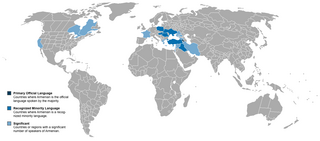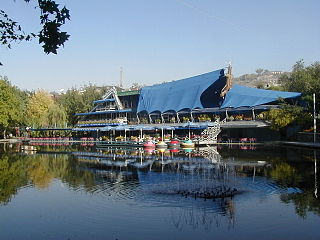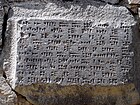
Soghomon Soghomonian, ordained and commonly known as Komitas, was an Armenian priest, musicologist, composer, arranger, singer, and choirmaster, who is considered the founder of the Armenian national school of music. He is recognized as one of the pioneers of ethnomusicology.

Alexander Grigori Arutiunian, also known as Arutunian, Arutyunyan, Arutjunjan, Harutyunian or Harutiunian, was a Soviet and Armenian composer and pianist, widely known for his 1950 trumpet concerto. A professor at Yerevan State Conservatory, he was recognized with many awards for his work, including the Stalin Prize in 1949 and People's Artist of the USSR in 1970, as well as numerous honors from his homeland of Armenia.

Arabkir, is one of the 12 districts of Yerevan, the capital of Armenia. Located to the north of the city centre, Arabkir is bordered by the Davtashen District from the northwest, Ajapnyak District from the west, Kentron District from the south, and Kanaker-Zeytun District from the east. Hrazdan River forms the natural border of the district from the north and the west. At the north, Arabkir has common borders with the community of Kanakeravan of Kotayk Province.

The Armenian Genocide memorial complex is Armenia's official memorial dedicated to the victims of the Armenian Genocide, built in 1967 on the hill of Tsitsernakaberd in Yerevan. Every year on April 24—the Armenian Genocide Remembrance Day—thousands of Armenians gather at the memorial to commemorate the victims of the genocide. The people who gather in Tsiternakaberd lay fresh flowers out of respect for all the people who died in the Armenian genocide. Over the years, from around the world, a wide range of politicians, artists, musician, athletes, and religious figures have visited the memorial.

Komitas State Conservatory of Yerevan, is a state-owned college of music located in Yerevan, Armenia. At the beginning, the institute was founded in 1921 as a music studio. However, in 1923, it was turned into a higher musical education institution. It is named after the founder of the Armenian national school of music, Komitas (1869−1935).

Ptghunk is a village in the Armenian province of Armavir. The village is about 10 miles from Yerevan on the road to Komitas, and is close to the Zvartnots airport. The population of Ptghunk is about 1,400.

Gohar Gasparyan also known as the "Armenian nightingale", was an Armenian opera singer.

Armenian National Academic Theatre of Opera and Ballet named after Alexander Spendiaryan in Yerevan was officially opened on 20 January 1933, with Alexander Spendiaryan's Almast opera performance. The opera building was designed by the Armenian architect Alexander Tamanian. It consists of two concert halls: the Aram Khatchaturian concert hall with 1,400 seats and the Alexander Spendiaryan Opera and Ballet National Theatre with 1,200 seats.
Armen Movsessian is a violin player. His formal training as a musician began as a child. He received his high school diploma from the Tchaikovsky's School of Music for the musically gifted, and earned his B.A. and Master’s from the Yerevan Conservatory named after Komitas. He was one of only fifty-four violinists worldwide to be invited to compete in the International Violin Competition of Indianapolis in 1990. This is when he decided to move to the United States and has since been named Concertmaster for the Panama National Symphony in Panama City, Panama, and for the New Hampshire Symphony Orchestra. Movsessian was an instructor of violin, viola, and chamber music at Clark University and an instructor of violin at the Longy School of Music, both in Massachusetts. He has performed during the 2003 and 2004
Ethnicity world tours with Yanni, as well as the 2005 Yanni Live! The Concert Event, and Yanni Voices tours.

Eduard Topchjan is an Armenian conductor, the principal conductor and artistic director of the Armenian Philharmonic Orchestra.

Kentron, is one of the 12 districts of Yerevan, the capital of Armenia. It comprises the downtown, the commercial centre of the city. As of the 2011 census, the district has a population of 125,453.

The Aram Khachaturian House-Museum opened in Yerevan, Armenia in 1982 and is devoted to the exhibition of the Armenian composer’s personal artifacts, as well as to the research and study of his creative output.

Siranush Gasparyan is an Armenian dramatic soprano.
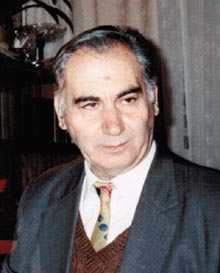
Nikoghos Tahmizian was an Armenian musicologist, theorist and historian. His professional accomplishments were to decipher neumes (khaz) of Armenian church music, analyze the musical theory of old Armenia and research the life and works of Armenian composers from medieval times to modern era.

Yerevan Vernissage is a large open-air market in Yerevan, Armenia. The name of the market is the derived from the French word vernissage. The market lies along Aram and Buzand streets at a length of 350 metres, connecting the Hanrapetutyun street with the Khanjyan street. The market mainly features a collection of different types of traditional Armenian art works.

Komitas Avenue is a 3 km-long avenue in the Armenian capital of Yerevan. Named after the prominent Armenian composer Komitas, the avenue is the arterial road of the Arabkir district. The avenue which was opened in 1938, starts with the Mergelyan Institute of Mathematical Machines near Komitas square and ends up with the Lambada bridge junction crossed by the Azatutyan Avenue.
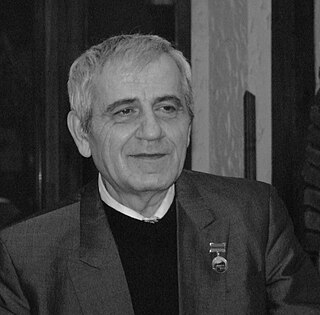
Ruben Sargsyan, also seen as Sarkisyan, was an Armenian composer, laureate of the State Award of the Republic of Armenia, professor of the Yerevan Komitas State Conservatory.
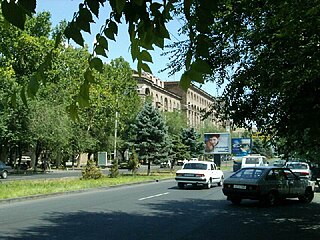
Sayat-Nova Avenue, is an avenue in the central Kentron District of Yerevan, Armenia. It is named after the 18th-century Armenian poet and musician Sayat-Nova. It was officially inaugurated on October 27, 1963.

Officially, Komitas Museum-Institute is an art and biographical museum in Yerevan, Armenia, devoted to the renowned Armenian musicologist and composer Komitas. It is located adjacent to the pantheon at the Komitas Park of Shengavit district. The museum was opened in January 2015.

